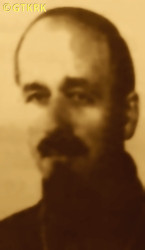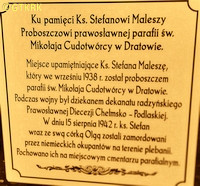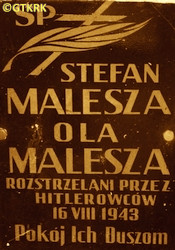Roman Catholic
St Sigismund parish
05-507 Słomczyn
85 Wiślana Str.
Konstancin deanery
Warsaw archdiocese, Poland
full list:
displayClick to display full list

searchClick to search full list by categories
wyświetlKliknij by wyświetlić pełną listę po polsku

szukajKliknij by przeszukać listę wg kategorii po polsku

Martyrology of the clergy — Poland
XX century (1914 – 1989)
personal data
surname
MALESZA
forename(s)
Steven (pl. Stefan)
function
presbiter (i.e. iereus)
creed
Eastern Orthodox Church ORmore on
en.wikipedia.org
[access: 2014.09.21]
diocese / province
Chełm‐Podlachia OR eparchy (Autocephalous Orthodox Church in the Generalgouvernement AOC‐GG)more on
pl.wikipedia.org
[access: 2021.08.20]
Warsaw‐Chełm OR eparchy (Polish Autocephalous Orthodox Church PAOC)
Pińsk‐Polesia OR eparchy (Polish Autocephalous Orthodox Church PAOC)more on
pl.wikipedia.org
[access: 2021.08.20]
nationality
Ukrainian
date and place
of death
15.08.1942

Dratówtoday: Ludwin gm., Łęczna pov., Lublin voiv., Poland
more on
en.wikipedia.org
[access: 2021.08.20]
details of death
During World War I, after the Russian defeat with the Germans and Austrians in the Battle of Gorlice in 05.1915, escaped with his parents deep into Russia (the so‐called bezhenstvo).
There called up for military service in a transport company in the Imperial Russian Army.
After the separatist Treaty of Brest on 03.03.1918, concluded between the German Empire, Austria–Hungary and Bolshevik Russia, returned to Poland.
In 07.1919, after Poland regained independence, volunteered for the Polish Army.
Served at the transport assembly station in Skierniewice, and then in the Framcesco Nullo 50th Borderland Rifle Regiment and the 44th Borderland Rifle Regiment.
Took part in the Polish–Russian war of 1919‐1921 (both regiments took part in battles with Russians in Wolyn in 1919‐1920, took part in Kiev offensive of 05.1920, defended Poland from Russian invasion in 1920).
In 1921 demobilized.
After German and Russian invasion of Poland in 09.1939 and start of the World War II, after start of German occupation, activist of the Ukrainian Aid Committee (UDK) prob. in Radzyń Podlaski, helping, according to sources, „children from poor families”. UDK was part of Ukrainian Central Committee UCK in Krakow, founded by the nationalist circles of the genocidal Ukrainian organization OUN, and collaborating with the Germans — the occupation authorities of the Germ. Generalgouvernement (Eng. General Governorate) GG.
Murdered prob. by the Germans (sources indicate an unspecified platoon of the Germ. Sonderpolizei, i.e. Eng. special police, independent from the Germ. Reichssicherheitshauptamt, i.e. Eng. Reich Main Security Office RSHA — assisted by agents of the Germ. Geheime Staatspolizei, i.e. Eng. Secret State Police Gestapo), together with his daughter, Olga, in front of his rectory.
alt. details of death
There are indications that could have been murdered by the Polish head of the Ludwin commune, who cooperated with the Germans.
That mayor confessed to this crime (and others, for which he was executed in 1948, after the end of military operations of World War II and the start of the Russian occupation), but the circumstances of this admission are unclear (he was interrogated by a Commie‐Nazi secret service UB officer who — such indicatications are also present — collaborated with the genocidal Ukrainian organization OUN/UPA and, during the occupation, with Germans).
cause of death
mass murder
perpetrators
Germans
sites and events
GeneralgouvernementClick to display the description, «Genocidium Atrox»Click to display the description, Ribbentrop‐MolotovClick to display the description, Polish‐Russian war of 1919‐1921Click to display the description
date and place
of birth
24.12.1893Birth certification on:
photos.szukajwarchiwach.gov.pl
[access: 2025.10.15]

Kanietoday: Rejowiec Fabryczny gm., Chełm pov., Lublin voiv., Poland
more on
pl.wikipedia.org
[access: 2021.08.20]
parents
MALESZA John
🞲 ?, ? — 🕆 ?, ?

FURMANIUK Josefa
🞲 ?, ? — 🕆 ?, ?
baptism
26.12.1893Birth certification on:
photos.szukajwarchiwach.gov.pl
[access: 2025.10.15]

Kanietoday: Rejowiec Fabryczny gm., Chełm pov., Lublin voiv., Poland
more on
pl.wikipedia.org
[access: 2021.08.20]
St Peter and St Paul the Apostles OR church
presbyter (holy orders)
ordination
21.10.1923

positions held
till 1942
dean — Radzyń Podlaskitoday: Radzyń Podlaski gm., Radzyń Podlaski pov., Lublin voiv., Poland
more on
en.wikipedia.org
[access: 2021.12.18] OR deanery
1938 – 1942
parish priest — Dratówtoday: Ludwin gm., Łęczna pov., Lublin voiv., Poland
more on
en.wikipedia.org
[access: 2021.08.20] ⋄ St Nicholas the Wonderworker OR parish ⋄ Radzyń Podlaskitoday: Radzyń Podlaski gm., Radzyń Podlaski pov., Lublin voiv., Poland
more on
en.wikipedia.org
[access: 2021.12.18] OR deanery
parish priest — Depułtycze Ruskietoday: Stare Depułtycze, Chełm gm., Chełm pov., Lublin voiv., Poland
more on
en.wikipedia.org
[access: 2024.03.15] ⋄ St Nicholas OR parish ⋄ Chełmtoday: Chełm city pov., Lublin voiv., Poland
more on
en.wikipedia.org
[access: 2021.08.20] OR deanery
from 1937
parish priest — Koniuchytoday: Miączyn gm., Zamość pov., Lublin voiv., Poland
more on
en.wikipedia.org
[access: 2024.03.15] ⋄ Holy Trinity OR parish ⋄ Chełmtoday: Chełm city pov., Lublin voiv., Poland
more on
en.wikipedia.org
[access: 2021.08.20] OR deanery
from 15.12.1934
psalmist — Chełmtoday: Chełm city pov., Lublin voiv., Poland
more on
en.wikipedia.org
[access: 2021.08.20] ⋄ St John the Evangelist OR cathedral church
psalmist — Zagrodytoday: Rejowiec gm., Chełm pov., Lublin voiv., Poland
more on
en.wikipedia.org
[access: 2024.01.29] ⋄ Intercession of the Blessed Virgin Mary OR church
14.12.1934
psalmist — Leszczanytoday: Żmudź gm., Chełm pov., Lublin voiv., Poland
more on
en.wikipedia.org
[access: 2024.01.29] ⋄ St Michael the Archangel OR church
from 07.08.1934
priest — Ślipczetoday: Hrubieszów urban gm., Hrubieszów pov., Lublin voiv., Poland
more on
en.wikipedia.org
[access: 2024.01.29] ⋄ St Michael the Archangel OR church ⋄ Hrubieszówtoday: Hrubieszów urban gm., Hrubieszów pov., Lublin voiv., Poland
more on
en.wikipedia.org
[access: 2021.08.20] OR deanery — acting („ad interim”)
from 15.05.1933
administrator — Vieliacičytoday: Pleshchitsy ssov., Pinsk dist., Brest reg., Belarus
more on
be.wikipedia.org
[access: 2023.04.10] ⋄ Nativity of the Blessed Virgin Mary OR church (fillial)
from 08.03.1933
administrator — Tutovychitoday: Sarny urban hrom., Sarny rai., Rivne obl., Ukraine
more on
uk.wikipedia.org
[access: 2022.07.05] ⋄ St Michael the Archangel OR church (fillial) ⋄ Sarny 2nd distr.Orthodox deanery name
today: Sarny rai., Rivne obl., Ukraine
more on
en.wikipedia.org
[access: 2021.09.17] OR deanery
c. 17.02.1933
parish priest — Bilska Volyatoday: Varash urban hrom., Varash rai., Rivne obl., Ukraine
more on
uk.wikipedia.org
[access: 2024.03.15] ⋄ St Paraskeva OR parish ⋄ Sarny 2nd distr.Orthodox deanery name
today: Sarny rai., Rivne obl., Ukraine
more on
en.wikipedia.org
[access: 2021.09.17] OR deanery
from 30.12.1932
administrator — Ozertsitoday: Varash urban hrom., Varash rai., Rivne obl., Ukraine
more on
uk.wikipedia.org
[access: 2024.03.15] ⋄ Nativity of the Blessed Virgin Mary OR church ⋄ Bilska Volyatoday: Varash urban hrom., Varash rai., Rivne obl., Ukraine
more on
uk.wikipedia.org
[access: 2024.03.15], St Paraskeva OR parish ⋄ Sarny 2nd distr.Orthodox deanery name
today: Sarny rai., Rivne obl., Ukraine
more on
en.wikipedia.org
[access: 2021.09.17] OR deanery
parish priest — Bilska Volyatoday: Varash urban hrom., Varash rai., Rivne obl., Ukraine
more on
uk.wikipedia.org
[access: 2024.03.15] ⋄ St Paraskeva OR parish ⋄ Sarny 2nd distr.Orthodox deanery name
today: Sarny rai., Rivne obl., Ukraine
more on
en.wikipedia.org
[access: 2021.09.17] OR deanery
from 27.05.1930
parish priest — Borshchevotoday: Kamyanyets ssov., Brest dist., Brest reg., Belarus
more on
be.wikipedia.org
[access: 2024.03.15] ⋄ St Onuphrius OR parish ⋄ Brest 3rd distr.Orthodox deanery name
today: Brest dist., Brest reg., Belarus
more on
en.wikipedia.org
[access: 2021.09.29] OR deanery
parish priest — Morochnetoday: Zarichne hrom., Varash rai., Rivne obl., Ukraine
more on
uk.wikipedia.org
[access: 2024.01.29] ⋄ St Paraskeva OR parish ⋄ Pinsk 3rd distr.Orthodox deanery name
today: Pinsk dist., Brest reg., Belarus
more on
en.wikipedia.org
[access: 2022.07.16] OR deanery
till 18.10.1926
parish priest — Strelnotoday: Sochivki ssov., Ivanava dist., Brest reg., Belarus
more on
be.wikipedia.org
[access: 2024.01.26] ⋄ St Alexander Nevsky OR parish ⋄ Drahichyn 2nd distr.Orthodox deanery name
today: Drahichyn dist., Brest reg., Belarus
more on
en.wikipedia.org
[access: 2023.07.16] OR deanery
from 10.11.1923
administrator — Kamień Szlacheckitoday: Oktyabr, Gorodets ssov., Kobryn dist., Brest reg., Belarus
more on
be.wikipedia.org
[access: 2024.01.26] ⋄ OR church (fillial) ⋄ Kobryn 3rd distr.Orthodox deanery name
today: Kobryn dist., Brest reg., Belarus
more on
en.wikipedia.org
[access: 2021.12.18] OR deanery — acting („ad interim”)
21.10.1923
presbiter (Eng. priest, i.e. iereus) — Polish Autocephalous Orthodox Church PACP — priesthood cheirotonia, i.e. ordination in Kremenetz, on 14.10.1923 preceded by deacon cheirotonia
1921 – c. 1923
teacher — Kobryntoday: Kobryn dist., Brest reg., Belarus
more on
en.wikipedia.org
[access: 2021.12.18] ⋄ primary schools — also: in neighboring villages
psalmist — Leszczanytoday: Żmudź gm., Chełm pov., Lublin voiv., Poland
more on
en.wikipedia.org
[access: 2024.01.29] ⋄ St Michael the Archangel OR church
1919 – 1921
soldier — Polish Armed Forces
c. 1918
psalmist — Ślipczetoday: Hrubieszów urban gm., Hrubieszów pov., Lublin voiv., Poland
more on
en.wikipedia.org
[access: 2024.01.29] ⋄ St Michael the Archangel OR church ⋄ Hrubieszówtoday: Hrubieszów urban gm., Hrubieszów pov., Lublin voiv., Poland
more on
en.wikipedia.org
[access: 2021.08.20] OR deanery
c. 1915 – c. 1917
soldier — Imperial Russian Army
till 1915
student — Chełmtoday: Chełm city pov., Lublin voiv., Poland
more on
en.wikipedia.org
[access: 2021.08.20] ⋄ philosophy and theology, Orthodox Theological Seminary
widower — two children
sites and events
descriptions
Generalgouvernement: After the Polish defeat in the 09.1939 campaign, which was the result of the Ribbentrop‐Molotov Pact and constituted the first stage of World War II, and the beginning of German occupation in part of Poland (in the other, eastern part of Poland, the Russian occupation began), the Germans divided the occupied Polish territory into five main regions. In two of them new German provinces were created, two other were incorporated into other provinces. However, the fifth part was treated separately, and in a political sense it was supposed to recreate the German idea from 1915 (during World War I, after the defeat of the Russians in the Battle of Gorlice in 05.1915) of creating a Polish enclave within Germany. Illegal in the sense of international law, i.e. Hague Convention, and public law, managed by the Germans according to separate laws — especially established for the Polish Germ. Untermenschen (Eng. subhumans) — till the Russian offensive in 1945 it constituted part of the Germ. Großdeutschland (Eng. Greater Germany). Till 31.07.1940 formally called Germ. Generalgouvernement für die besetzten polnischen Gebiete (Eng. General Government for the occupied Polish lands) — later simply Germ. Generalgouvernement (Eng. General Governorate), as in the years 1915‐1918. From 07.1941, i.e. after the German attack on 22.06.1941 against the erstwhile ally, the Russians, it also included the Galicia district, i.e. the Polish pre‐war south‐eastern voivodeships. A special criminal law was enacted and applied to Poles and Jews, allowing for the arbitrary administration of the death penalty regardless of the age of the „perpetrator”, and sanctioning the use of collective responsibility. After the end of the military conflict of the World War UU, the government of the Germ. Generalgouvernement was recognized as a criminal organization, and its leader, governor Hans Frank, guilty of war crimes and crimes against humanity and executed. (more on: en.wikipedia.orgClick to attempt to display webpage
[access: 2024.12.13])
«Genocidium Atrox»: In 1939‐1947, especially in 1943‐1944, independent Ukrainian units, mainly belonging to genocidal Ukrainian organizations OUN (political arm) and UPA (military arm), supported by local Ukrainian population, murdered — often in extremely brutal way — in Volyn and surrounding regions of pre‐war Poland, from 130,000 to 180,000 Poles, all civilians: men, women, children, old and young. Polish‐Ukrainian conflict that openly emerged during and after World War I (in particular resulting in Polish‐Ukrainian war of 1918‐1919), that survived and even deepened later when western Ukraine became a part Poland, exploded again after the outbreak of the World War II in 09.1939. During Russian occupation of 1939‐1941, when hundreds of thousands of Poles were deported into central Russia, when tens of thousands were murdered (during so‐called Katyń massacres, among others), this open conflict had a limited character, helped by the fact that at that time Ukrainians, Ukrainian nationalists in particular, were also persecuted by the Russians. The worst came after German‐Russian war started on 22.06.1941 and German occupation resulted. Initially Ukrainians supported Germans (Ukrainian police was initiated, Ukrainians co—participated in extermination of the Jews and were joining army units fighting alongside Germans). Later when German ambivalent position towards Ukraine became apparent Ukrainians started acting independently. And in 1943 one of the units of aforementioned Ukrainian OUN/UPA organization, in Volyn, started and perpetrated a genocide of Polish population of this region. In mere few weeks OUN/UPA murdered, with Germans passively watching on the sidelines, more than 40,000 Poles. This strategy was consequently approved and adopted by all OUN/UPA organisations and similar genocides took place in Eastern Lesser Poland (part of Ukraine) where more than 20,000 Poles were slaughtered, meeting however with growing resistance from Polish population. Further west, in Chełm, Rzeszów, etc. regions this genocide turned into an extremely bloody conflict. In general genocide, perpetrated by Ukrainian nationalists, partly collaborating with German occupants, on vulnerable Polish population took part in hundreds of villages and small towns, where virtually all Polish inhabitants were wiped out. More than 200 priests, religious and nuns perished in this holocaust — known as «Genocidium Atrox» (Eng. „savage genocide”) The nature and purpose of genocide is perhaps best reflected in the song sung by the murderers: „We will slaughter the Poles, we will cut down the Jews, we must conquer the great Ukraine” (ukr. „Поляків виріжем, Євреїв видусим, велику Україну здобути мусим”). This holocaust and conflict ended up in total elimination of Polish population and Polish culture from Ukraine, in enforced deportations in 1944‐1945 of remaining Poles from Ukraine and some Ukrainians into Ukraine proper, and finally in deportation of Ukrainians from East‐South to the Western parts of Polish republic prl by Commie‐Nazi Russian controlled Polish security forces („Vistula Action”). (more on: www.swzygmunt.knc.plClick to attempt to display webpage
[access: 2021.06.20])
Ribbentrop‐Molotov: Genocidal Russian‐German alliance pact between Russian leader Joseph Stalin and German leader Adolf Hitler signed on 23.08.1939 in Moscow by respective foreign ministers, Mr. Vyacheslav Molotov for Russia and Joachim von Ribbentrop for Germany. The pact sanctioned and was the direct cause of joint Russian and German invasion of Poland and the outbreak of the World War II in 09.1939. In a political sense, the pact was an attempt to restore the status quo ante before 1914, with one exception, namely the „commercial” exchange of the so‐called „Kingdom of Poland”, which in 1914 was part of the Russian Empire, fore Eastern Galicia (today's western Ukraine), in 1914 belonging to the Austro‐Hungarian Empire. Galicia, including Lviv, was to be taken over by the Russians, the „Kingdom of Poland” — under the name of the General Governorate — Germany. The resultant „war was one of the greatest calamities and dramas of humanity in history, for two atheistic and anti‐Christian ideologies — national and international socialism — rejected God and His fifth Decalogue commandment: Thou shall not kill!” (Abp Stanislav Gądecki, 01.09.2019). The decisions taken — backed up by the betrayal of the formal allies of Poland, France and Germany, which on 12.09.1939, at a joint conference in Abbeville, decided not to provide aid to attacked Poland and not to take military action against Germany (a clear breach of treaty obligations with Poland) — were on 28.09.1939 slightly altered and made more precise when a treaty on „German‐Russian boundaries and friendship” was agreed by the same murderous signatories. One of its findings was establishment of spheres of influence in Central and Eastern Europe and in consequence IV partition of Poland. In one of its secret annexes agreed, that: „the Signatories will not tolerate on its respective territories any Polish propaganda that affects the territory of the other Side. On their respective territories they will suppress all such propaganda and inform each other of the measures taken to accomplish it”. The agreements resulted in a series of meeting between two genocidal organization representing both sides — German Gestapo and Russian NKVD when coordination of efforts to exterminate Polish intelligentsia and Polish leading classes (in Germany called «Intelligenzaktion», in Russia took the form of Katyń massacres) where discussed. Resulted in deaths of hundreds of thousands of Polish intelligentsia, including thousands of priests presented here, and tens of millions of ordinary people,. The results of this Russian‐German pact lasted till 1989 and are still in evidence even today. (more on: en.wikipedia.orgClick to attempt to display webpage
[access: 2015.09.30])
Polish‐Russian war of 1919‐1921: War for independence of Poland and its borders. Poland regained independence in 1918 but had to fight for its borders with former imperial powers, in particular Russia. Russia planned to incite Bolshevik‐like revolutions in the Western Europe and thus invaded Poland. Russian invaders were defeated in 08.1920 in a battle called Warsaw battle („Vistula river miracle”, one of the 10 most important battles in history, according to some historians). Thanks to this victory Poland recaptured part of the lands lost during partitions of Poland in XVIII century, and Europe was saved from the genocidal Communism. (more on: en.wikipedia.orgClick to attempt to display webpage
[access: 2014.12.20])
sources
personal:
lublin.cerkiew.plClick to attempt to display webpage
[access: 2021.08.20], wnet.fmClick to attempt to display webpage
[access: 2021.08.20], frpl.plClick to attempt to display webpage
[access: 2024.01.29], photos.szukajwarchiwach.gov.plClick to attempt to display webpage
[access: 2025.10.15], archiwum.przegladprawoslawny.plClick to attempt to display webpage
[access: 2021.08.20]
bibliographical:
„Hierachy, clergy and employees of the Orthodox Church in the 19th‐21st centuries within the borders of the Second Polish Republic and post–war Poland”, Fr Gregory Sosna, M. Antonine Troc-Sosna, Warsaw–Bielsk Podlaski 2017
original images:
gminaludwin.plClick to attempt to display webpage
[access: 2021.08.20], ukrainskanekropolia.orgClick to attempt to display webpage
[access: 2024.01.29]
LETTER to CUSTODIAN/ADMINISTRATOR
If you have an Email client on your communicator/computer — such as Mozilla Thunderbird, Windows Mail or Microsoft Outlook, described at WikipediaPatrz:
en.wikipedia.org, among others — try the link below, please:
LETTER to CUSTODIAN/ADMINISTRATORClick and try to call your own Email client
If however you do not run such a client or the above link is not active please send an email to the Custodian/Administrator using your account — in your customary email/correspondence engine — at the following address:

giving the following as the subject:
MARTYROLOGY: MALESZA Steven
To return to the biography press below:
 Click to return to biography
Click to return to biography










